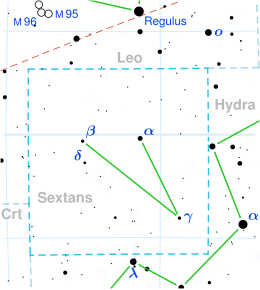| Observation data Epoch J2000 Equinox J2000 | |
|---|---|
| Constellation | Sextans |
| Right ascension | 10h 25m 44.27091s [1] |
| Declination | −07° 03′ 35.3764″ [1] |
| Apparent magnitude (V) | 5.56 [2] |
| Characteristics | |
| Evolutionary stage | AGB [3] |
| Spectral type | K6 III Fe −0.5 [4] |
| U−B color index | +1.86 [2] |
| B−V color index | +1.53 [2] |
| Variable type | suspected [5] |
| Astrometry | |
| Radial velocity (Rv) | 35.60±0.25 [6] km/s |
| Proper motion (μ) | RA: −135.763 mas/yr [1] Dec.: +130.341 mas/yr [1] |
| Parallax (π) | 7.127±0.1702 mas [1] |
| Distance | 460 ± 10 ly (140 ± 3 pc) |
| Absolute magnitude (MV) | +0.19 [7] |
| Details | |
| Mass | 0.44±0.14 [8] M☉ |
| Radius | 41.1±2.1 [9] R☉ |
| Luminosity | 252±9 [10] L☉ |
| Surface gravity (log g) | 0.96+0.02 −0.03 [11] cgs |
| Temperature | 3,804 [12] K |
| Metallicity [Fe/H] | −0.10±0.05 [8] dex |
| Rotational velocity (v sin i) | 1.5±1.0 [13] km/s |
| Age | 11.0+1.9 −1.6 [8] Gyr |
| Other designations | |
| 47 G. Sextantis [14] , NSV 18399, BD−06°3146, FK5 2836, GC 14321, HD 90362, HIP 51046, HR 4092, SAO 137557, CCDM J10258-0704A, WDS J10257-0704A, TIC 36881111 [15] | |
| Database references | |
| SIMBAD | data |
HD 90362 (HR 4092; 47 G. Sextantis) is a solitary star [16] located in the equatorial constellation of Sextans. It is faintly visible to the naked eye as a redish-orange-hued point of light with an apparent magnitude of 5.56. [2] Gaia DR3 parallax measurements imply a distance of approximately 460 light-years [1] and it is receding with a heliocentric radial velocity of 35.6 km/s . [6] At its current distance, HD 90362's brightness is diminished by an interstellar extinction of 0.19 magnitudes [17] and it has an absolute magnitude of +0.19. [7]
HD 90362 is an old population II star [18] with a stellar classification of K6 III Fe −0.5, [4] indicating that it is an evolved K-type giant that has exhausted hydrogen at its core and left the main sequence along with a mild spectral underabundance of iron. It is currently on the asymptotic giant branch, generating energy via the fusion of hydrogen and helium shells around an inert carbon core. [3] It has only 44% the mass of the Sun [8] but at the age of 11 billion years, [8] it has expanded to 41.1 times the radius of the Sun. [9] It radiates 252 times the luminosity of the Sun [10] from its enlarged photosphere at an effective temperature of 3,804 K . [12] HD 90362 is metal deficient with an iron abundance of [Fe/H] = −0.1 or 79.4% of the Sun's [8] and it spins slowly with a projected rotational velocity of approximately 1.5 km/s . [13]
The variability of the star was first detected in 1997 by the Hipparcos mission. [19] It found variations between 5.69 and 5.72 in the Hipparcos passband. As of 2004, its variability has not been confirmed. [20] HD 90362 has an optical companion located 142.6" away along a position angle of 100° as of 2010. [21] It was first observed by M. Scaria in 1981. [21]
